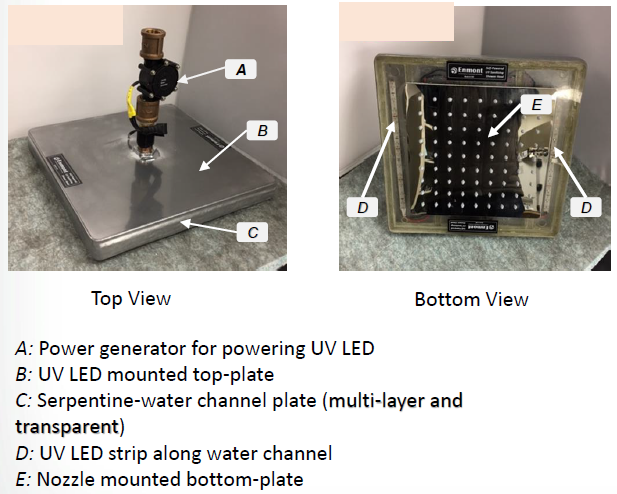UV-LED Showerhead Invention Reduces Risk of Legionella Contamination

Published February 1, 2022
Legionella bacteria are found naturally in the environment worldwide, usually in aquatic environments. The bacteria also occur in water distribution systems and premise plumbing. Legionella pneumophila is one of EPA’s Contaminant Candidate List microorganisms and one of three major premise plumbing pathogens. Unlike other waterborne enteric pathogens, Legionella exposure can result from breathing in water droplets containing the bacteria, suggesting showering with hot water is the most vulnerable point of Legionella intrusion. Sometimes the bacteria infect the lungs and can cause a severe pneumonia called Legionnaires' disease. According to the CDC, most healthy people do not get Legionnaires’ disease after being exposed to Legionella. However, older adults or those with lung problems or weakened immune systems have an increased chance of getting sick.
Although tap water meets drinking water regulations, opportunistic premise plumbing pathogens (OPPPs), such as Legionella, are frequently detected in hot water, resulting in contaminated aerosolized hot water being inhaled during hot showers. To significantly reduce the risk of contamination, EPA researcher Hodon Ryu invented a showerhead that uses low power ultraviolet (UV) light emitting diodes (LEDs) to inactivate OPPPs in hot water.
Preventing Legionella in premise plumbing systems presents complex challenges due to its persistence in biofilm, resistance to disinfection, and complex microbial ecology in pipe wall surface area. UV light has been successfully used to treat a broad suite of pathogens without the associated formation of carcinogenic disinfection by-products. However, conventional mercury UV lamps have some practical limitations in water treatment applications, such as inefficient energy consumption and, more importantly, potential mercury contamination upon disposal of the lamps. Comparatively, the emerging light-emitting diodes (LED) device generating germicidal UV wavelengths is smaller, lighter, less fragile, and mercury-free. Moreover, it has enormous potential for the point-of-use (POU) devices in water disinfection.
The UV-LED Showerhead can improve water quality in a wide range of products (for example, public showers, ultrasonic humidifiers, misting systems in grocery stores, and whirlpools) by effectively reducing OPPPs in hot water. There are many applicable functions, including in hospitals, senior care facilities, and other buildings where immunosuppressed individuals are at risk from infections of OPPPs. Also, the UV-LED Showerhead could be used in military facilities, particularly in aircraft carriers and VA hospitals, significantly reducing the risk of exposure to Legionella and other OPPPs. One main benefit of the UV-LED Showerhead is that it can be manufactured and distributed for the same cost as standard showerheads, keeping overhead costs the same while enhancing water quality and decreasing outbreaks of harmful microorganisms in premise plumbing systems.
The UV-LED Showerhead is a patented technology in the United States and is available for licensing by qualified businesses interested in bringing the product to market. Interested parties can apply for a license by completing EPA’s license application and submitting it to EPA’s Federal Technology Transfer Act (FTTA) staff.
Learn more:
